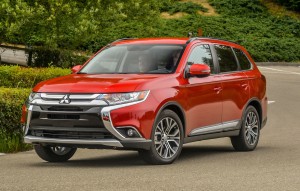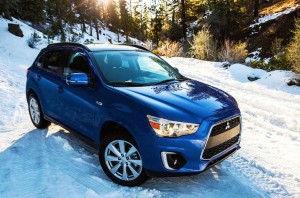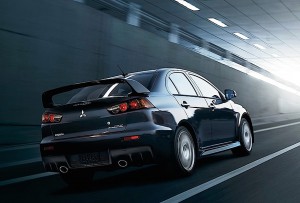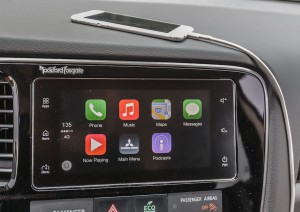
Mitsubishi officials are counting on the appeal of sport-utes to drive sales of its Outlander while it searches for a partner in the U.S.
In the lingo of the auto industry, there are minor updates, major refreshes, complete makeovers – and on occasion, a Hail Mary Pass. Mitsubishi Motors has had to throw several of those since barely dodging bankruptcy during the Great Recession.
A look at the Japanese maker’s latest numbers suggests a few of them have resulted in scores. Mitsubishi Motor Sales of America reported its first operating profit in some time for 2014. And last month, it reported its best sales figures since 2008.
That news coincides with the launch of MMSA’s 2016 Outlander utility vehicle. A “major-minor,” to stick with industry-speak, it gets more than just the normal mid-lifecycle tweaks. And it will have to carry a bigger load than in the past as Mitsubishi trims down its line-up, shifting focus primarily to its utility vehicles.
Even there, the maker faces some serious challenges, senior officials acknowledge. To develop the sort of competitive line-up Mitsubishi needs is likely beyond the company’s budget and is all but certain to require finding a partner, said Don Swearingen, MMSA Executive Vice President. And observers question whether that means the company will be able to long remain an independent entity.
Founded in April 1970, Mitsubishi Motors is Japan’s sixth largest automaker, and 16th worldwide. It spent much of its early years in the shadows. If Americans knew its products it was because they were sold in the U.S. through various Chrysler brands, such as the old Dodge Colt. Only in the ’80s did the Japanese maker set up its own American distribution network.
But Mitsubishi Motor Sales of America has led the proverbial rollercoaster existence. It started generating record sales early in the new millennium, but at a steep cost. The company turned to so-called NINJA loans – short for No Income, No Jobs or Assets – to draw in young buyers who, in record numbers, walked away from their debts, handing back the keys for products like the sporty Mitsubishi Eclipse, when the economy went south. Losses ran up towards $500 million.
Meanwhile, what was supposed to be a three-way alliance with the former DaimlerChrysler AG fell apart when that ill-fated “merger of equals” collapsed.” When compounded by broader global issues, Mitsubishi Motors survived only with a bailout from the broader Mitsubishi network, or keiretsu, including Mitsubishi Heavy Industry, Mitsubishi Corp. and Mitsubishi Bank. In turn, these new, preferred shareholders demanded massive cost-cutting that all but froze the carmaker’s product development program.
Those debts have been paid off, but the impact was steep. Mitsubishi eliminated a number of products worldwide, and it has had to drop others from the critical U.S. market – such as the “hot-hatch” Evolution Lancer model – because it can’t justify the cost of homologating it to meet American regulations. Other model launches have been pushed back, forcing MMSA to rely on long-in-the-tooth offerings.
No surprise, said Swearingen, during a media preview of the 2016 Mitsubishi Outlander in San Francisco this week, that “Some of you in this room may have written us off. But,” he quickly declared, “we’re here to stay.”
In trimmed-down form, anyway. In a separate conversation, Swearingen outlined for TheDetroitBureau.com his goals for the U.S. On the product side, there is an all-new version of the smaller Outlander Sport coming in a couple years. It will pick up on the edgy new design language Mitsubishi has been highlighting with a series of recent concept cars.
Further out, Swearingen says he hopes to get a new C-segment, or compact, sedan, as well as a similar-sized crossover. And he’d like to get a larger utility vehicle, essentially a replacement for the old Mitsubishi Montero that can’t come to the U.S. because it would cost too much to homologate. A longer-term goal would also deliver a compact pickup to the more than 300 U.S. dealers to replace the once-popular Mighty Max.
The problem is that all these products would be costly, more costly than Mitsubishi can afford. So it needs to find a partner. It tried to do a deal with Renault for a large sedan to replace the old Mitsubishi Diamante, but “financially, it did not make sense,” concedes Swearingen.
(Mitsubishi Outlander makes impact at NY Auto Show. For more, Click Here.)
Who else is out there? Old partner Chrysler – and its own partner Fiat – is today looking find allies. “There’s nothing there I can talk about right now,” said Swearingen.
He does note that Mitsubishi also would like to find a partner to help share its seriously underutilized assembly plant in Normal, Illinois – which was originally opened in an earlier era along with Chrysler. Today, that factory produces barely a third of its 240,000-unit annual capacity.
(Click Here for details about how much longer the good times will roll for auto sales.)
But that brings out another challenge for Mitsubishi. Currently the Illinois plant is the only Japanese-owned assembly plant with a unionized workforce. And industry sources suggest that may be scaring away some potential partners.
In the short-term, Swearingen and his team are more upbeat than they have been in years, and a survey by the National Automobile Dealers Association finds the carmaker’s retailers more optimistic than at any time since the Great Recession. Even the few new products they’re getting, like the 2016 Outlander, should help. It is expected to generate further “double-digit” sales gains, according to Swearingen.
But will that be enough?
“I would expect, over the long-term, they’re going to be one of the ones who’ll partner up or be consolidated,” forecast analyst Joe Phillippi, of AutoTrends Consulting, who attended this week’s Outlander introduction. He suggested that the increasingly ambitious Chinese auto industry might see a ripe opportunity in Mitsubishi.
(To see why Japanese automakers can expect to gain U.S. marketshare in the near term, Click Here.)
For his part, Swearingen insisted the Japanese maker is “not looking at a merger.” But in the increasingly competitive global auto industry – one in which many expect to see sizable consolidation – Mitsubishi may not have enough Hail Mary passes left to keep playing the game on its own.



